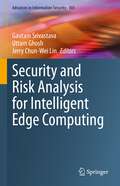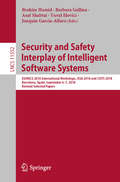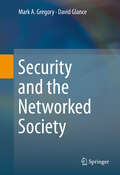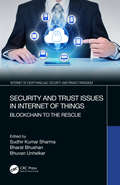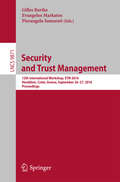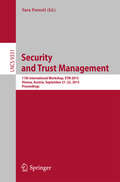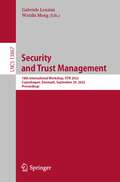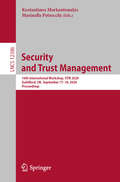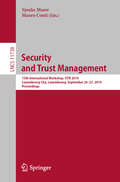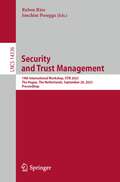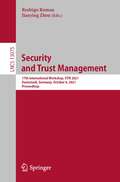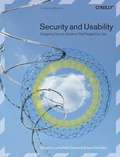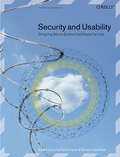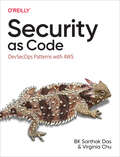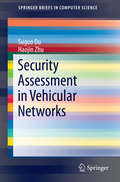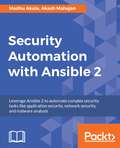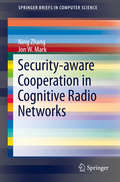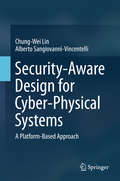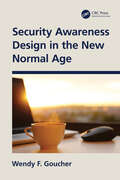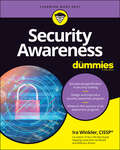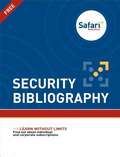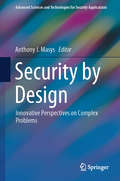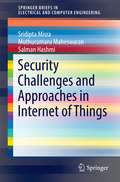- Table View
- List View
Security and Risk Analysis for Intelligent Edge Computing (Advances in Information Security #103)
by Gautam Srivastava Uttam Ghosh Jerry Chun-Wei LinThis book offers the latest research results in security and privacy for Intelligent Edge Computing Systems. It presents state-of-the art content and provides an in-depth overview of the basic background in this related field. Practical areas in both security and risk analysis are addressed as well as connections directly linked to Edge Computing paradigms. This book also offers an excellent foundation on the fundamental concepts and principles of security, privacy and risk analysis in Edge Computation infrastructures. It guides the reader through the core ideas with relevant ease. Edge Computing has burst onto the computational scene offering key technologies for allowing more flexibility at the edge of networks. As Edge Computing has evolved as well as the need for more in-depth solutions in security, privacy and risk analysis at the edge. This book includes various case studies and applications on Edge Computing. It includes the Internet of Things related areas, such as smart cities, blockchain, mobile networks, federated learning, cryptography and cybersecurity. This book is one of the first reference books covering security and risk analysis in Edge Computing Systems. Researchers and advanced-level students studying or working in Edge Computing and related security fields will find this book useful as a reference. Decision makers, managers and professionals working within these fields will want to purchase this book as well.
Security and Safety Interplay of Intelligent Software Systems: ESORICS 2018 International Workshops, ISSA 2018 and CSITS 2018, Barcelona, Spain, September 6–7, 2018, Revised Selected Papers (Lecture Notes in Computer Science #11552)
by Brahim Hamid Barbara Gallina Asaf Shabtai Yuval Elovici Joaquin Garcia-AlfaroThis book constitutes the thoroughly refereed post-conference proceedings of the International Workshop on Interplay of Security, Safety and System/Software Architecture, CSITS 2018, and the International Workshop on Cyber Security for Intelligent Transportation Systems, ISSA 2018, held in Barcelona, Spain, in September 2018, in conjunction with the 23rd European Symposium on Research in Computer Security, ESORICS 2018.The ISSA 2018 workshop received 10 submissions from which 3 full papers and 1 short paper were accepted. They cover topics such as software security engineering, domain-specific security and privacy architectures, and automative security. In addition, an invited paper on safety and security co-engineering intertwining is included. The CSITS 2018 workshop received 9 submissions from which 5 full papers and 1 short paper were accepted. The selected papers deal with car security and aviation security.
Security and the Networked Society
by Mark A. Gregory David GlanceThis book examines technological and social events during 2011 and 2012, a period that saw the rise of the hacktivist, the move to mobile platforms, and the ubiquity of social networks. It covers key technological issues such as hacking, cyber-crime, cyber-security and cyber-warfare, the internet, smart phones, electronic security, and information privacy. This book traces the rise into prominence of these issues while also exploring the resulting cultural reaction. The authors' analysis forms the basis of a discussion on future technological directions and their potential impact on society. The book includes forewords by Professor Margaret Gardner AO, Vice-Chancellor and President of RMIT University, and by Professor Robyn Owens, Deputy Vice-Chancellor (Research) at the University of Western Australia. Security and the Networked Society provides a reference for professionals and industry analysts studying digital technologies. Advanced-level students in computer science and electrical engineering will also find this book useful as a thought-provoking resource.
Security and Trust Issues in Internet of Things: Blockchain to the Rescue (Internet of Everything (IoE))
by Sudhir Kumar Sharma, Bharat Bhushan, and Bhuvan UnhelkarThe purpose of this edited book is to present and showcase the basic fundamentals, applications, and integration of both IoT and Blockchain. The trend of applying Blockchain to IoT is rapidly growing because it helps to overcome various challenges faced by IoT, from smart manufacturing to unmanned aerial vehicles. Thise book aims to showcase the basics of both IoT and Blockchain as well as the integration and challenges for existing practitioners. Thise book initiates conversations among technologists, engineers, scientists, and clinicians to synergize their efforts in producing low-cost, high-performance, highly efficient, deployable IoT systems. Thise book is theory-based and is useful for engineers from various disciplines, including industrial engineering, computer science, electronics, telecommunications, electrical, agricultural, and cybersecurity, along with researchers, professionals, and students.
Security and Trust Management
by Gilles Barthe Evangelos Markatos Pierangela SamaratiThis book constitutes the thoroughly refereed post-conference proceedings of the 6th International Workshop on Security and Trust Management, STM 2010, held in Athens, Greece, in September 2010. The 17 revised full papers presented were carefully reviewed and selected from 40 submissions. Focusing on high-quality original unpublished research, case studies, and implementation experiences, STM 2010 encouraged submissions discussing the application and deployment of security technologies in practice.
Security and Trust Management
by Sara ForestiThis book constitutes the refereed proceedings of the 11th International Workshop on Security and Trust Management, STM 2015, held in Vienna, Austria, in September 2015, in conjunction with the 20th European Symposium Research in Computer Security, ESORICS 2015. The 15 revised full papers were carefully reviewed and selected from 38 submissions. They are organized in topical sections as security metrics and classification; data protection; intrusion detection and software vulnerabilities; cryptographic protocols; controlling data release; and security analysis, risk management and usability.
Security and Trust Management: 18th International Workshop, STM 2022, Copenhagen, Denmark, September 29, 2022, Proceedings (Lecture Notes in Computer Science #13867)
by Gabriele Lenzini Weizhi MengThis book constitutes the post proceedings of the 18th International Workshop on Security and Trust Management, STM 2022, co-located with the 27th European Symposium on Research in Computer Security, ESORICS 2022, which took place in Copenhagen, Denmark, in September 2022.The 7 full papers together with 4 short papers included in this volume were carefully reviewed and selected from 18 submissions. The workshop presents papers with topics such as security and trust access control, cryptographic protocols, identity management, security metrics, and privacy.
Security and Trust Management: 16th International Workshop, STM 2020, Guildford, UK, September 17–18, 2020, Proceedings (Lecture Notes in Computer Science #12386)
by Kostantinos Markantonakis Marinella PetrocchiThis book constitutes the proceedings of the 16th International Workshop on Security and Trust Management, STM 2020, co-located with the 25th European Symposium on Research in Computer Security, ESORICS 2020. The conference was planned to take place in Guildford, UK, but had to be moved to an online format due to the COVID-19 pandemic. The workshop took place during September 17-18, 2020. The 8 papers presented in this volume were carefully reviewed and selected from 20 submissions. They were organized in topical sections on security properties and attacks; confidentiality schema and security processes.
Security and Trust Management: 15th International Workshop, STM 2019, Luxembourg City, Luxembourg, September 26–27, 2019, Proceedings (Lecture Notes in Computer Science #11738)
by Sjouke Mauw Mauro ContiThis book constitutes the proceedings of the 15th International Workshop on Security and Trust Management, STM 2019, held in Luxembourg City, Luxembourg, in September 2019, and co-located with the 24th European Symposium Research in Computer Security, ESORICS 2019. The 9 full papers and 1 short paper were carefully reviewed and selected from 23 submissions. The papers present novel research on all theoretical and practical aspects of security and trust in ICTs.
Security and Trust Management: 19th International Workshop, STM 2023, The Hague, The Netherlands, September 28, 2023, Proceedings (Lecture Notes in Computer Science #14336)
by Ruben Rios Joachim PoseggaThis book constitutes the proceedings of the 19th International Workshop on Security and Trust Management, STM 2023, co-located with the 28th European Symposium on Research in Computer Security, ESORICS 2023, held in The Hague, The Netherlands, during September 28th, 2023 The 5 full papers together with 4 short papers included in this volume were carefully reviewed and selected from 15 submissions. The workshop presents papers with topics such as security and privacy, trust models, security services, authentication, identity management, systems security, distributed systems security, privacy-preserving protocols.
Security and Trust Management: 17th International Workshop, STM 2021, Darmstadt, Germany, October 8, 2021, Proceedings (Lecture Notes in Computer Science #13075)
by Rodrigo Roman Jianying ZhouThis book constitutes the proceedings of the 17th International Workshop on Security and Trust Management, STM 2021, co-located with the 26th European Symposium on Research in Computer Security, ESORICS 2021. The conference was planned to take place in Darmstadt, Germany. It was held online on October 8, 2021, due to the COVID-19 pandemic.The 10 papers presented in this volume were carefully reviewed and selected from 26 submissions. They were organized in topical sections on applied cryptography; privacy; formal methods for security and trust; and systems security.
Security and Usability
by Lorrie Cranor Simson GarfinkelHuman factors and usability issues have traditionally played a limited role in security research and secure systems development. Security experts have largely ignored usability issues--both because they often failed to recognize the importance of human factors and because they lacked the expertise to address them. But there is a growing recognition that today's security problems can be solved only by addressing issues of usability and human factors. Increasingly, well-publicized security breaches are attributed to human errors that might have been prevented through more usable software. Indeed, the world's future cyber-security depends upon the deployment of security technology that can be broadly used by untrained computer users. Still, many people believe there is an inherent trade-off between computer security and usability. It's true that a computer without passwords is usable, but not very secure. A computer that makes you authenticate every five minutes with a password and a fresh drop of blood might be very secure, but nobody would use it. Clearly, people need computers, and if they can't use one that's secure, they'll use one that isn't. Unfortunately, unsecured systems aren't usable for long, either. They get hacked, compromised, and otherwise rendered useless. There is increasing agreement that we need to design secure systems that people can actually use, but less agreement about how to reach this goal. Security and Usability is the first book-length work describing the current state of the art in this emerging field. Edited by security experts Dr. Lorrie Faith Cranor and Dr. Simson Garfinkel, and authored by cutting-edge security and human-computer interaction (HCI) researchers world-wide, this volume is expected to become both a classic reference and an inspiration for future research. Security and Usability groups 34 essays into six parts: Realigning Usability and Security-- with careful attention to user-centered design principles, security and usability can be synergistic. Authentication Mechanisms-- techniques for identifying and authenticating computer users. Secure Systems-- how system software can deliver or destroy a secure user experience. Privacy and Anonymity Systems-- methods for allowing people to control the release of personal information. Commercializing Usability: The Vendor Perspective-- specific experiences of security and software vendors (e.g., IBM, Microsoft, Lotus, Firefox, and Zone Labs) in addressing usability. The Classics-- groundbreaking papers that sparked the field of security and usability. This book is expected to start an avalanche of discussion, new ideas, and further advances in this important field.
Security and Usability: Designing Secure Systems that People Can Use
by Simson Garfinkel Lorrie Faith CranorHuman factors and usability issues have traditionally played a limited role in security research and secure systems development. Security experts have largely ignored usability issues--both because they often failed to recognize the importance of human factors and because they lacked the expertise to address them. But there is a growing recognition that today's security problems can be solved only by addressing issues of usability and human factors. Increasingly, well-publicized security breaches are attributed to human errors that might have been prevented through more usable software. Indeed, the world's future cyber-security depends upon the deployment of security technology that can be broadly used by untrained computer users. Still, many people believe there is an inherent tradeoff between computer security and usability. It's true that a computer without passwords is usable, but not very secure. A computer that makes you authenticate every five minutes with a password and a fresh drop of blood might be very secure, but nobody would use it. Clearly, people need computers, and if they can't use one that's secure, they'll use one that isn't. Unfortunately, unsecured systems aren't usable for long, either. They get hacked, compromised, and otherwise rendered useless. There is increasing agreement that we need to design secure systems that people can actually use, but less agreement about how to reach this goal. Security & Usability is the first book-length work describing the current state of the art in this emerging field. Edited by security experts Dr. Lorrie Faith Cranor and Dr. Simson Garfinkel, and authored by cutting-edge security and human-computer interaction (HCI) researchers world-wide, this volume is expected to become both a classic reference and an inspiration for future research. Security & Usability groups 34 essays into six parts: Realigning Usability and Security---with careful attention to user-centered design principles, security and usability can be synergistic. Authentication Mechanisms-- techniques for identifying and authenticating computer users. Secure Systems--how system software can deliver or destroy a secure user experience. Privacy and Anonymity Systems--methods for allowing people to control the release of personal information. Commercializing Usability: The Vendor Perspective--specific experiences of security and software vendors (e.g., IBM, Microsoft, Lotus, Firefox, and Zone Labs) in addressing usability. The Classics--groundbreaking papers that sparked the field of security and usability. This book is expected to start an avalanche of discussion, new ideas, and further advances in this important field.
Security as Code
by Bk Sarthak Das Virginia ChuDevOps engineers, developers, and security engineers have ever-changing roles to play in today's cloud native world. In order to build secure and resilient applications, you have to be equipped with security knowledge. Enter security as code.In this book, authors BK Sarthak Das and Virginia Chu demonstrate how to use this methodology to secure any application and infrastructure you want to deploy. With Security as Code, you'll learn how to create a secure containerized application with Kubernetes using CI/CD tooling from AWS and open source providers.This practical book also provides common patterns and methods to securely develop infrastructure for resilient and highly available backups that you can restore with just minimal manual intervention.Learn the tools of the trade, using Kubernetes and the AWS Code SuiteSet up infrastructure as code and run scans to detect misconfigured resources in your codeCreate secure logging patterns with CloudWatch and other toolsRestrict system access to authorized users with role-based access control (RBAC)Inject faults to test the resiliency of your application with AWS Fault Injector or open source toolingLearn how to pull everything together into one deployment
Security Assessment in Vehicular Networks
by Suguo Du Haojin ZhuThis book presents several novel approaches to model the interaction between the attacker and the defender and assess the security of Vehicular Ad Hoc Networks (VANETs). The first security assessment approach is based on the attack tree security assessment model, which leverages tree based methods to analyze the risk of the system and identify the possible attacking strategies the adversaries may launch. To further capture the interaction between the attacker and the defender, the authors propose to utilize the attack-defense tree model to express the potential countermeasures which could mitigate the system. By considering rational participants that aim to maximize their payoff function, the brief describes a game-theoretic analysis approach to investigate the possible strategies that the security administrator and the attacker could adopt. A phased attack-defense game allows the reader to model the interactions between the attacker and defender for VANET security assessment. The brief offers a variety of methods for assessing the security of wireless networks. Professionals and researchers working on the defense of VANETs will find this material valuable.
Security Automation with Ansible 2: Leverage Ansible 2 to automate complex security tasks like application security, network security, and malware analysis
by Madhu Akula Akash MahajanAutomate security-related tasks in a structured, modular fashion using the best open source automation tool available About This Book • Leverage the agentless, push-based power of Ansible 2 to automate security tasks • Learn to write playbooks that apply security to any part of your system • This recipe-based guide will teach you to use Ansible 2 for various use cases such as fraud detection, network security, governance, and more Who This Book Is For If you are a system administrator or a DevOps engineer with responsibility for finding loop holes in your system or application, then this book is for you. It's also useful for security consultants looking to automate their infrastructure's security model. What You Will Learn • Use Ansible playbooks, roles, modules, and templating to build generic, testable playbooks • Manage Linux and Windows hosts remotely in a repeatable and predictable manner • See how to perform security patch management, and security hardening with scheduling and automation • Set up AWS Lambda for a serverless automated defense • Run continuous security scans against your hosts and automatically fix and harden the gaps • Extend Ansible to write your custom modules and use them as part of your already existing security automation programs • Perform automation security audit checks for applications using Ansible • Manage secrets in Ansible using Ansible Vault In Detail Security automation is one of the most interesting skills to have nowadays. Ansible allows you to write automation procedures once and use them across your entire infrastructure. This book will teach you the best way to use Ansible for seemingly complex tasks by using the various building blocks available and creating solutions that are easy to teach others, store for later, perform version control on, and repeat. We'll start by covering various popular modules and writing simple playbooks to showcase those modules. You'll see how this can be applied over a variety of platforms and operating systems, whether they are Windows/Linux bare metal servers or containers on a cloud platform. Once the bare bones automation is in place, you'll learn how to leverage tools such as Ansible Tower or even Jenkins to create scheduled repeatable processes around security patching, security hardening, compliance reports, monitoring of systems, and so on. Moving on, you'll delve into useful security automation techniques and approaches, and learn how to extend Ansible for enhanced security. While on the way, we will tackle topics like how to manage secrets, how to manage all the playbooks that we will create and how to enable collaboration using Ansible Galaxy. In the final stretch, we'll tackle how to extend the modules of Ansible for our use, and do all the previous tasks in a programmatic manner to get even more powerful automation frameworks and rigs. Style and approach This comprehensive guide will teach you to manage Linux and Windows hosts remotely in a repeatable and predictable manner. The book takes an in-depth approach and helps you understand how to set up complicated stacks of software with codified and easy-to-share best practices.
Security-aware Cooperation in Cognitive Radio Networks
by Ning Zhang Jon W. MarkThis brief investigates spectrum efficient and energy efficient strategies, known as cognitive radio networks (CRNs), to ensure secure cooperation between licensed and unlicensed users. The authors address issues of spectrum scarcity, spectrum sensing, transmission performance, trust-aware cooperation, and secure communications. Two security-aware cooperation based spectrum access schemes are presented. The first is a trust-aware cooperative framework for CRNs to improve the throughput or energy efficiency of licensed users and offer transmission opportunities to unlicensed users, taking into consideration the trustworthiness of unlicensed users. The second scheme is a cooperative framework to enhance secure communications of licensed users. An introduction to CRNs and literature survey enhance the discussion while numerical results are provided to demonstrate the viability of the proposed schemes. The brief is designed for researchers and professionals working with cognitive radio networks or interested in cooperation based access. Advanced-level students studying computer communication networks and communications engineering will also find this brief useful.
Security-Aware Design for Cyber-Physical Systems
by Chung-Wei Lin Alberto Sangiovanni-VincentelliAddressing the rising security issues during the design stages of cyber-physical systems, this book develops a systematic approach to address security at early design stages together with all other design constraints. Cyber-attacks become more threatening as systems are becoming more connected with the surrounding environment, infrastructures, and other systems. Security mechanisms can be designed to protect against attacks and meet security requirements, but there are many challenges of applying security mechanisms to cyber-physical systems including open environments, limited resources, strict timing requirements, and large number of devices. Designed for researchers and professionals, this book is valuable for individuals working in network systems, security mechanisms, and system design. It is also suitable for advanced-level students of computer science.
Security Awareness Design in the New Normal Age
by Wendy F. GoucherPeople working in our cyber world have access to a wide range of information including sensitive personal or corporate information which increases the risk to it. One of the aspects of the protection of this data is to train the user to behave more securely. This means that every person who handles sensitive information, their own or that of other people, be aware of the risks that their use can pose as well as how to do their job in such a way as to reduce that risk. The approach we use for that is called ‘Security awareness’ but would be more accurately described as security ‘un-awareness’ because most of the problems come where the user doesn’t know about a risk from their behaviour, or its potential impact. In these post COVID days of ‘New Normal’ working, in which staff spend more of their time working at home, organisations are still responsible for the protection of sensitive personal and corporate data. This means that it is more important than ever to create an effective security awareness communication process. This book will primarily consider the problem of hitting that ‘Sweet Spot’ in the age of ‘New Normal' working, which means that the knowledge about secure practice is not only understood and remembered, but also reliably put into practice – even when a person is working alone. This will be informed by academic research as well as experience, both my own and learnt from my fellow professionals, and then will be used to demonstrate how ‘New Normal’ working can improve security awareness as well as challenge it.
Security Awareness For Dummies
by Ira WinklerMake security a priority on your team Every organization needs a strong security program. One recent study estimated that a hacker attack occurs somewhere every 37 seconds. Since security programs are only as effective as a team’s willingness to follow their rules and protocols, it’s increasingly necessary to have not just a widely accessible gold standard of security, but also a practical plan for rolling it out and getting others on board with following it. Security Awareness For Dummies gives you the blueprint for implementing this sort of holistic and hyper-secure program in your organization. Written by one of the world’s most influential security professionals—and an Information Systems Security Association Hall of Famer—this pragmatic and easy-to-follow book provides a framework for creating new and highly effective awareness programs from scratch, as well as steps to take to improve on existing ones. It also covers how to measure and evaluate the success of your program and highlight its value to management. Customize and create your own program Make employees aware of the importance of security Develop metrics for success Follow industry-specific sample programs Cyberattacks aren’t going away anytime soon: get this smart, friendly guide on how to get a workgroup on board with their role in security and save your organization big money in the long run.
Security Bibliography
by Safari Content TeamPeople are increasingly concerned by the security of the information they put online and worry about their privacy and their online profile. With new attacks, information leaks, vulnerabilities and exploits published every week, information security is a constant learning process. To be effective and stay up to date, you need the right resources to make sure you can quickly access any needed information. Obtaining the details you need is like trying to find a needle in a haystack. From general IT security knowledge and certifications to specialized content such as exploit writing, this bibliography brings together the right resources to help you get the information you need to solve any problem in IT security. We cover mobile and network security, cyber warfare and cyber crime and how to confront malware, including detection, development and forensics. And with more and more code written every day, secure coding is crucial, and we cover books on secure development, cryptography development, guidelines and best practices.
The Security Breach Files: An AFK Book (Five Nights At Freddy's)
by Scott CawthonEverything fans will want to know about the newest Five Night's at Freddy's game "Security Breach", in a deluxe hardcover!A deep dive into the newest Five Nights at Freddy's game is presented here in a giant hardcover that will make the perfect addition to any fan’s library. From the newest animatronics to the deepest maps and easter eggs, everything is laid out in awesome detail that will deepen the knowledge of even the most enthusiastic player. A must-have for Freddy Fans!
Security Breach Files Updated Edition: An AFK Book (Five Nights At Freddy's)
by Scott CawthonCrack open this updated edition of the Security Breach Files for a deep dive into the terrifying game!All that you want to know about the first free-roam Five Nights at Freddy's game is presented here in vivid detail, with thirty-two new pages taking you through the free story "Ruin".This comprehensive breakdown covering gameplay, secrets, Easter eggs, and alternate endings for both the main game and DLC will deepen the knowledge of even the most enthusiastic player. All the evidence, along with every detail of the newest entry into the world of Five Nights at Freddy's is laid out for fans to explore in this one-of-a-kind guide.
Security by Design: Innovative Perspectives on Complex Problems (Advanced Sciences and Technologies for Security Applications)
by Anthony J. MasysThis edited book captures salient global security challenges and presents ‘design’ solutions in dealing with wicked problems. Through case studies and applied research this book reveals the many perspectives, tools and approaches to support security design. Security design thereby can support risk and threat analysis, risk communication, problem framing and development of interventions strategies. From the refugee crisis to economic slowdowns in emerging markets, from ever-rising numbers of terrorist and cyberattacks to global water shortages, to the proliferation of the Internet of Things and its impact on the security of our homes, cities and critical infrastructure, the current security landscape is diverse and complex. These global risks have been in the headlines in the last year (Global Risks Report) and pose significant security challenges both nationally and globally. In fact, national security is no longer just national. Non-state actors, cyber NGO, rising powers, and hybrid wars and crimes in strategic areas pose complex challenges to global security. In the words of Horst Rittel (1968):"Design is an activity, which aims at the production of a plan, which plan -if implemented- is intended to bring about a situation with specific desired characteristics without creating unforeseen and undesired side and after effects."
Security Challenges and Approaches in Internet of Things
by Sridipta Misra Muthucumaru Maheswaran Salman HashmiThis book provides a comprehensive survey of the security and privacy research advancements in Internet of Things (IoT). The book lays the context for the discussion by introducing a system model for IoT. Since IoT is very varied and has been introduced in many different contexts, the system model introduced plays a crucial role in integrating the concepts into a coherent framework. After the system model, the book introduces the vulnerable features of the IoT. By providing a comprehensive discussion of the vulnerable features, the book highlights the problem areas of IoT that should be studied concerning security and privacy. Using the vulnerable features as a motivation, the book presents a vast survey of existing security and privacy approaches for IoT. The survey is a good way for the reader to pick up interesting directions of research that have already been explored and also hints at directions that could take additional investigation. Finally, the book presents four case studies that provide a detailed view of how some of the security and privacy concerns are addressed in specific problem areas.
